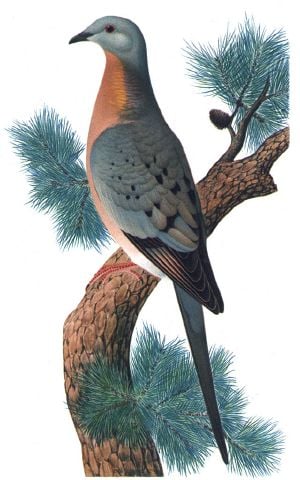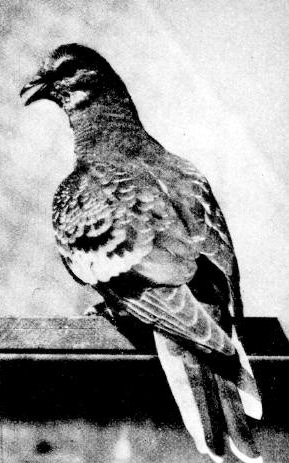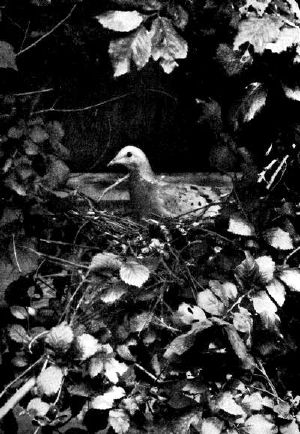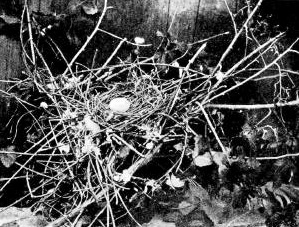| Passenger Pigeon | ||||||||||||||
|---|---|---|---|---|---|---|---|---|---|---|---|---|---|---|
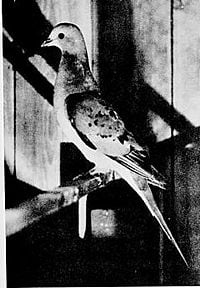 1898 photograph of a live Passenger Pigeon
| ||||||||||||||
| Scientific classification | ||||||||||||||
| ||||||||||||||
| Ectopistes migratorius (Linnaeus, 1766) |
Passenger pigeon is the common name for an extinct migratory bird, Ectopistes migratorius, of the Columbidae family, that was a very common bird in North America as recently as the mid-nineteenth century. These short-billed, small-headed, social pigeons, about one foot long and with a long-pointed tail, lived in enormous flocks. During migration, billions of birds, in flocks up to a mile wide and hundreds of miles long, could take days to pass overhead. They also are known as wild pigeons.
However, during the nineteenth century, the species went from being one of the most abundant birds in the world, and the most common North American bird, to extinction (IUCN 2004). In 1900, the last wild bird was shot, and in 1914, the last captive bird died in the Cincinnati Zoo. Contributing factors included loss of habitat and food, disease, hunting, and breakdown of social facilitation as flocks declined. A primary factor emerged when pigeon meat was commercialized as a cheap food for slaves and the poor in the nineteenth century, resulting in hunting on a massive scale.
The extinction of the passenger pigeon aroused public interest in the conservation movement and resulted in new laws and practices that have prevented many other species from going extinct.
Description
The passenger pigeon was a plump bird, with short legs, a small head, a short neck, and a short and slender bill with two nares that lead to the respiratory system. As with other members of Columbidae, passenger pigeon were monogamous, used pigeons milk to feed their young, and were capable of drinking by sucking up water, without the need to tilt the head backward.
During summer, passenger pigeons lived in forest habitats throughout North America east of the Rocky Mountains: From eastern and central Canada to the northeast United States. In the winters, they migrated to the southern United States and occasionally to Mexico and Cuba.
The passenger pigeon was a very social bird. It lived in colonies stretching over hundreds of square miles, practicing communal breeding with up to a hundred nests in a single tree. Since no accurate data were recorded, it is only possible to give estimates on the size and population of these nesting areas. Each site may have covered many thousands of acres and the birds were so congested in these areas that hundreds of nests could be counted in each tree. One large nesting in Wisconsin was reported as covering 850 square miles, and the number of birds nesting there was estimated to be around 136,000,000.
Pigeon migration, in flocks numbering billions, was a spectacle without parallel. During migration, it was possible to see flocks of them a mile (1.6 km) wide and 300 miles (500 km) long, taking several days to pass and containing up to a billion birds (NYT 1910; BBN 2006). Passenger pigeons had one of the largest groups or flocks of any animal, second only to the desert locust. They became such a threat to farmers that in 1703, the Roman Catholic bishop of Quebec actually formally excommunicated the species (Mann 2005).
There was safety in large flocks. When a flock of this huge a size established itself in an area, the number of local animal predators (such as wolves, foxes, weasels, and hawks) was so small compared to the total number of birds that little damage would be inflicted on the flock as a whole. (Of course, when human beings would become the predators, the large flocks became a detriment, as they were readily hunted in mass.)
Some estimate that there were from 3 billion to 5 passenger pigeons in the United States at the time Europeans arrived in North America, making up about 25 to 40 percent of the total bird population (SI 2001). Others argue that the species had not been common in the Pre-Columbian period, and may even have been a rare species, but their numbers grew when devastation of the American Indian population by European diseases led to reduced competition for food (Mann 2005).
There was a slow decline in their numbers between about 1800 and 1870, followed by a catastrophic decline between 1870 and 1890 (SNL). "Martha," thought to be the world's last passenger pigeon, died on September 1, 1914, in the zoo in Cincinnati, Ohio.
The term "passenger pigeon" in English derives from the French word passager, meaning "to pass by."
Causes of extinction
Multiple causes have been suggested for the extinction of the passenger pigeon. Historically, the primary cause was held to be the commercial exploitation of pigeon meat on a massive scale (SI 2001). However, current examination focuses on the pigeon's loss of habitat. The International Union for Conservation of Nature and Natural Resources (IUCN), states the extinction "was ultimately due to the effects of widespread clearance of its mast food, with the proximate causes being Newcastle disease, extensive hunting and the breakdown of social facilitation" (IUCN 2008).
The passenger pigeon has long been hunted. Even prior to colonization, native Americans occasionally used pigeons for meat. In the early 1800s, commercial hunters began netting and shooting the birds to sell in the city markets as food, as live targets for trap shooting, and even as agricultural fertilizer.
Once pigeon meat became popular, commercial hunting started on a prodigious scale. The bird painter John James Audubon described the preparations for slaughter at a known pigeon-roosting site (Audobon 1946):
Few pigeons were then to be seen, but a great number of persons, with horses and wagons, guns and ammunition, had already established encampments on the borders. Two farmers from the vicinity of Russelsville, distant more than a hundred miles, had driven upwards of three hundred hogs to be fattened on the pigeons which were to be slaughtered. Here and there, the people employed in plucking and salting what had already been procured, were seen sitting in the midst of large piles of these birds. The dung lay several inches deep, covering the whole extent of the roosting-place.
Pigeons were shipped by the boxcar-load to the Eastern cities. In New York City, in 1805, a pair of pigeons sold for two cents. Slaves and servants in eighteenth and nineteenth century America often saw no other meat. By the 1850s, it was noticed that the numbers of birds seemed to be decreasing, but still the slaughter continued, accelerating to an even greater level as more railroads and telegraphs were developed after the American Civil War. Three million pigeons were shipped by a single market hunter in the year 1878.
Another significant reason for the passenger pigeon's extinction was deforestation. Possibly, the birds also may have suffered from Newcastle disease, an infectious bird disease that was introduced to North America; though the disease was identified in 1926, it has been posited as one of the factors leading to the extinction of the passenger pigeon.
Attempts to revive the species by breeding the surviving captive birds were not successful. The passenger pigeon was a colonial and gregarious bird, practicing communal roosting and communal breeding and needed large numbers for optimum breeding conditions. It was impossible to reestablish the species with just a few captive birds, and the small captive flocks weakened and died. Even when market hunting was discontinued, because it was not longer profitable, thousands of birds had remained in suitable habitat, but these still declined, apparently as a result of the need to nest in large colonies (IDNR).
The passenger pigeon's technique of survival had been based on mass tactics. The birds traveled and reproduced in prodigious numbers, satiating predators before any substantial negative impact was made in the bird's population. This colonial way of life and communal breeding became very dangerous when humans became a predator on the flocks. When the passenger pigeons were massed together, especially at a huge nesting site, it was easy for humans to slaughter them in such great numbers that there were not enough birds left to successfully reproduce the species (SI 2001). As their numbers decreased along with their habitat, the birds could no longer rely on high population density for protection. Without this mechanism, many ecologists believe, the species could not survive. As the flocks dwindled in size with resulting breakdown of social facilitation, the species became beyond the point of recovery.
Coextinction
An often-cited example of coextinction is that of the passenger pigeon and its parasitic lice Columbicola extinctus and Campanulotes defectus. However, 'C. extinctus was rediscovered on the band-tailed pigeon, and C. defectus was found to be a likely case of mis-identification of the existing Campanulotes flavus (Clayton and Price 1999; Price et al. 2000).
Methods of killing
Diverse method were used for attracting and killing passenger pigeons. In some cases, alcohol-soaked grain was used to bait them, or fires were started beneath their nests (IDNR). One method of killing was to blind a single bird by sewing its eyes shut using a needle and thread. This bird's feet would be attached to a circular stool at the end of a stick that could be raised five or six feet in the air, then dropped back to the ground. As the bird attempted to land, it would flutter its wings, thus attracting the attention of other birds flying overhead. When the flock landed near this decoy bird, nets would trap the birds and the hunters would crush their heads between their thumb and forefinger. This has been claimed as the origin of the term stool pigeon (Henrici 193), though this etymology is disputed (Quinion 2008).
One of the last large nestings of passenger pigeons was at Petoskey, Michigan, in 1878. Here about 50,000 birds were killed each day and the hunt continued for nearly five months. When the adult birds that survived the slaughter attempted second nestings at new sites, they were located by the professional hunters and killed before they had a chance to raise any young. In 1896, the final flock of 250,000 were killed by American sportsmen knowing that it was the last flock of that size.
Conservationists were ineffective in stopping the slaughter. A bill was passed in the Michigan legislature making it illegal to net pigeons within two miles of a nesting area, but the law was weakly enforced. By the mid 1890s, the passenger pigeon had almost completely disappeared. It was too late to protect them by passing laws. In 1897, a bill was introduced in the Michigan legislature asking for a ten-year closed season on passenger pigeons. This was a futile gesture. A highly gregarious species, the flock could initiate courtship and reproduction only when they were gathered in large numbers; it was realized only too late that smaller groups of passenger pigeons could not breed successfully, and the surviving numbers proved too few to re-establish the species (SI 2001).
Last survivors
Last wild survivors
In 1910, the naturalist Charles Dury, of Cincinnati, Ohio, wrote (Dury 1910):
One foggy day in October 1884, at 5 a.m. I looked out of my bedroom window, and as I looked six wild pigeons flew down and perched on the dead branches of a tall poplar tree that stood about one hundred feet away. As I gazed at them in delight, feeling as though old friends had come back, they quickly darted away and disappeared in the fog, the last I ever saw of any of these birds in this vicinity.
The last fully authenticated record of a wild bird was near Sargents, Pike County, Ohio, on March 22, 1900 (SI 2001). (The date of March 24 was given in the report by Henniger, but there are many discrepancies with the actual circumstances, meaning he was writing from hearsay. A curator's note that apparently derives from an old specimen label has March 22. However, there were many unconfirmed sightings reported in the first decade of the twentieth century (Howell 1924; McKinley 1960). From 1909 to 1912, a reward was offered for a living specimen (NYT 1910); no specimens were found. However, unconfirmed sightings continued up to about 1930 (SNL 1930).
Last captive survivor: Martha
In 1857, a bill was brought forth to the Ohio State Legislature seeking protection for the passenger pigeon. A Select Committee of the Senate filed a report stating "The passenger pigeon needs no protection. Wonderfully prolific, having the vast forests of the North as its breeding grounds, traveling hundreds of miles in search of food, it is here today and elsewhere tomorrow, and no ordinary destruction can lessen them, or be missed from the myriads that are yearly produced" (Hornaday 1913).
Fifty-seven years later, on September 1, 1914, Martha, the last known passenger pigeon, died in the Cincinnati Zoo, Cincinnati, Ohio. Her body was frozen into a block of ice and sent to the Smithsonian Institution, where it was skinned and mounted. Currently, Martha (named after Martha Washington) is in the museum's archived collection, and not on display (SI 2001).
ReferencesISBN links support NWE through referral fees
- Audubon, J. J. 1946. On the passenger pigeon. In J. J. Audubon, Birds of America. New York: Macmillan.
- BNet Business Network (BBN). 2006. Gone forever. BNet Business Network. Retrieved October 27, 2008.
- Clayton, D. H., and R. D. Price. 1999. Taxonomy of New World Columbicola (Phthiraptera: Philopteridae) from the Columbiformes (Aves), with descriptions of five new species. Ann. Entomol. Soc. Am. 92: 675–685.
- Dury, C. 1910. The passenger pigeon. Journal of the Cincinnati Society of Natural History 21: 52–56.
- Eckert, A. W. 1965. The Silent Sky: The Incredible Extinction of the Passenger Pigeon. Lincoln, NE: IUniverse.com. ISBN 0595089631.
- Henrichi, M. 1930. Stool pigeon. Time.com. Retrieved October 27, 2008.
- Hornaday, W. T. 1913: Our Vanishing Wild Life. Its Extermination and Preservation. New York, C. Scribner's Sons.
- Howell, A. H. 1924. Birds of Alabama. Ulala. Retrieved October 27. 2008.
- Iowa Department of Natural Resources (IDNR). n.d. Iowa’s wildlife resource base. Iowa Department of Natural Resources. Retrieved October 27, 2008.
- International Union for Conservation of Nature and Natural Resources (IUCN). 2008. Ectopistes migratorius. 2008 IUCN Red List of Threatened Species. Retrieved October 27, 2008.
- Mann, C. C. 2005. 1491: New Revelations of the Americas before Columbus. New York: Alfred A. Knopf. ISBN 140004006X.
- McKinley, D. 1960. A history of the passenger pigeon In Missouri. Auk 77: 399-420.
- New York Times (NYT). Three hundred dollars reward; Will be paid for a nesting pair of wild pigeons, a bird so common in the United States fifty years ago that flocks in the migratory period frequently partially obscured the sun from view. How America has lost birds of rare value and how science plans to save those that are left. New York Times January 16, 1910.
- Price, R. D., D. H. Clayton, and R. J. Adams. 2000. Pigeon lice down under: Taxonomy of Australian Campanulotes (Phthiraptera: Philopteridae), with a description of C. durdeni n.sp.. Parasitol. 86(5): 948-950.
- Quinion, M. n.d. Stool pigeon. World Wide Words. Retrieved October 27, 2008.
- Science Netlinks (SNL). n.d. Passenger pigeon timeline. Science Netlinks. Retrieved October 27, 2008.
- Science News Letters. 1930. Passenger pigeon. Science News Letters 17: 136.
- Schorger, A. W. 1955. The Passenger Pigeon: Its Natural History and Extinction. Madison, WI: University of Wisconsin Press. ISBN 1930665962.
- Smithsonian Institute (SI), Department of Vertebrate Zoology, National Museum of Natural History. 2001. The passenger pigeon. Encyclopedia Smithsonian. Retrieved October 27, 2008.
- Weidensaul, S. 1994. Mountains of the Heart: A Natural History of the Appalachians. Golden, Colorado: Fulcrum Publishing. ISBN 1555911439.
Credits
New World Encyclopedia writers and editors rewrote and completed the Wikipedia article in accordance with New World Encyclopedia standards. This article abides by terms of the Creative Commons CC-by-sa 3.0 License (CC-by-sa), which may be used and disseminated with proper attribution. Credit is due under the terms of this license that can reference both the New World Encyclopedia contributors and the selfless volunteer contributors of the Wikimedia Foundation. To cite this article click here for a list of acceptable citing formats.The history of earlier contributions by wikipedians is accessible to researchers here:
The history of this article since it was imported to New World Encyclopedia:
Note: Some restrictions may apply to use of individual images which are separately licensed.

